ASTR 1210 (O'Connell) Study Guide
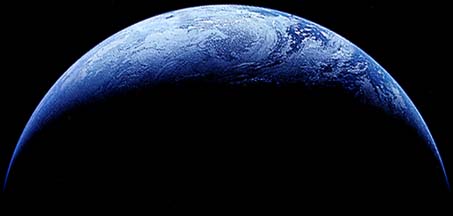
A. Earth as a Planet: Uniqueness
- Largest terrestrial planet
- Has largest satellite with respect to its own diameter (see images in Guide 13)
- Large atmospheric abundance of water is unique among terrestrials
- Open oceans: unique in the solar system; water covers 2/3 of Earth's surface and produces its signature blue color
- Oxygen-rich atmosphere (21% by volume)
- Life! Living organisms cover the Earth.
-
There is no definite evidence yet for any other biospheres in the
solar system. If these exist, the lifeforms are likely to be
primitive. See Guide 23.
B. The Earth's Biosphere
- Consists of Earth's crust, oceans, lower atmosphere:

- Thin!. A total thickness of about 25 km (15 miles), compared to Earth's 8000 mile diameter. For a sense of the thinness of the atmosphere, see this picture.
- For a scale model: Take a piece of paper. Fold once. Paste on a basketball. A thin smear of lifeforms on a huge sphere.
- Fragile!
- We live in a delicate balance with nature
- In cosmic time, our favorable ecosystem is transient and
evolving rapidly.
- For example: Earth's surface, as hard and unchanging as it may seem, is only temporary.
- Although the rapidly growing human population (see Study Guides 9 and 19) is having deleterious effects on the biosphere, these are survivable (even if the costs could be enormous). The most serious, long-term threats to the ecosystem are extraterrestrial and beyond immediate human control: asteroid/comet impacts, solar evolution, supernovae and other stellar explosions, etc.
- Astronomy is the ultimate ecology.
C. The Age of the Earth
Our experience of everyday time is of little help in visualizing the age of the Earth. Hundreds or thousands of years represent the longest time scales we can easily comprehend, yet the age of the Earth is millions of times longer.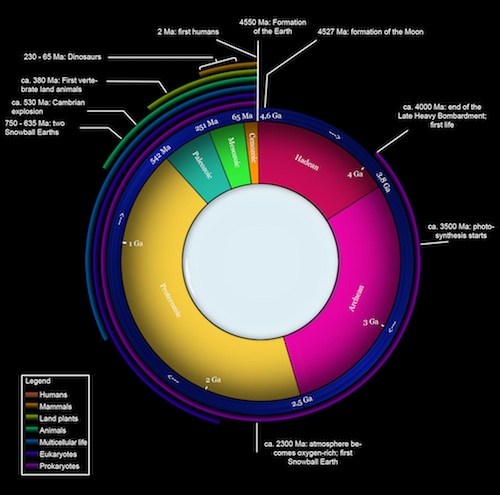 The model time scale described
in Study Guide 1, based on the pages in our
textbook, is probably the best way of attempting to retrain your
thinking about cosmic time.
The model time scale described
in Study Guide 1, based on the pages in our
textbook, is probably the best way of attempting to retrain your
thinking about cosmic time.
- Another useful illustration is in the form of the face of a
"cosmic clock." An example is shown at the right. At this scale, you
can't even see the current era of human dominance. Click for a
full-sized version.
Throughout the vast majority of its history, the Earth's atmosphere,
surface features, and especially its lifeforms, were dramatically
different from what we experience today.
- Sedimentation rate/geological strata method
- Developed in the 19th century (after road and railroad construction exposed deep rock layers)
- The rock layers of the Grand Canyon, for example, were once under water. They are hardened sediment that settled to the floors of ancient seas, deposited over long periods of time by rivers that flowed into the oceans. The sedimentary layers can contain fossils of ancient plants and animals. They can also harbor processed organic material in the form of oil and natural gas.
- Age-dating based on stratigraphy makes use of the relatively uniform rate of sediment deposition to estimate the age of different stata. Deeper layers are older, and thicker layers were exposed to deposition for a longer period of time. For an example of dating of the Grand Canyon, click on the picture below. "Bio-stratigraphy" uses embedded fossils to refine ages.
- These methods are not very precise, but they were sufficient to prove to 19th century geologists that the Earth's surface had evolved over at least millions of years of time. This recognition has been called "the discovery of Deep Time."
- Stratigraphy is still very important in determining the relative ages for different rock formations, which can be traced across huge geographical areas. Here is a pertinent example, showing the distribution of the recently exploited gas-rich Marcellus shale formation across the eastern US.

Sedimentary layers in the walls of the Grand Canyon (Reiner Stenzel). Click for cross-sectional ages.
- Radioisotope (or "radiometric") dating method
- This is based on the well-determined decay rates of the nuclei of naturally occurring radioactive ("unstable") isotopes, e.g. uranium ==> lead. It is much more precise than stratigraphy, and the basic mechanism is thoroughly understood on the basis of quantum mechanics. It can be applied to rock samples obtained anywhere on the Earth or elsewhere in the solar system (e.g. from the Moon or meteorites).
- The "half life" of an unstable isotope is the time it takes for half of the original sample to decay to a "daughter" isotope. See this Java Applet illustrating the decay process. Half lives for unstable isotopes are determined by the structure of their nuclei and range from microseconds to billions of years.
- Method: first, chemically separate parent from daughter isotopes;
then estimate the age from the ratio of parent to daughter.
-
"Carbon-14" dating is the best known type of radiometric dating.
Because the half-life of 14C is only 5570 years, it is
very important for studies of historical and pre-historical human
artifacts; but it is not useful for geological time scales.
For time scales up to billions of years, dating schemes using
decay chains such as uranium-lead
or rubidium-strontium are used. These can yield
a dating precision in the range of 0.1-2%.
- Result: The age of the Earth is about 4.5 billion years, based on
the dating of many different kinds of samples.
- The oldest Earth surface rocks: 3.9 billion years (a few samples of zircon crystal date to 4.4 Byr)
- Moon rocks & soil, meteorites:
4.5-4.6 billion years
-
The oldest Earth surface rocks are younger than those of the
Moon, even though the Earth probably formed somewhat earlier than the
Moon, because the Earth's surface has been recycled by plate
tectonics.
- Examples of Earth chronologies (click):
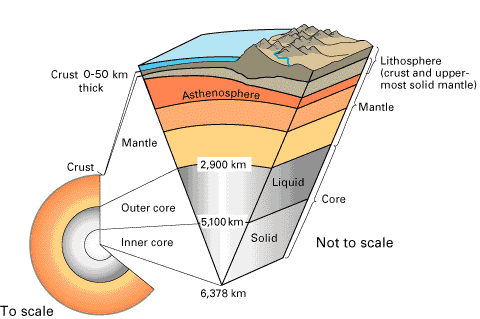 Cross-section through the Earth (USGS)
Cross-section through the Earth (USGS)
D. Earth's Interior
- Earth's mass can be determined from the orbit of the Moon or of
artificial spacecraft by applying Kepler's 3rd
law.
- Reminder: the Earth's mass can not be determined from its orbit around the Sun (see Study Guide 8).
- The density of a planet, defined to be its mass
divided by its volume, is an essential clue to its composition.
Despite is much smaller diameter, Earth has a higher density
than does Jupiter:
- Earth 5.5 grams/cc ==> heavier elements (like Si,O,Fe)
- Jupiter 1.3 grams/cc ==> lighter elements (H,He)
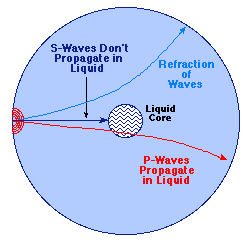
- We are able to probe the interior
using seismic
waves from earthquakes
- These show that the interior is differentiated: i.e. the composition and density change with depth
- 3 main zones: Core (innermost), mantle (body), crust (outermost).
(See illustration above.) - Densities range from 12 grams/cc in the core to 3 grams/cc in the crust, implying that the core contains more heavy elements than the crust.
- Temperature at the core is over 5000 K.
- The differentiation implies that Earth's interior was once
molten, so that heavier materials could settle to the
center.
- Initial heat source: impacts of infalling planetesimals during formation stages. Further heat was released during differentiation, as heavier materials sank.
- A persistent (lasting billions of years) interior heat source: radioactive decay of uranium and other materials. Even though they constitute only a small fraction of the Earth's makeup, the heat generated by decay of these materials escapes only slowly, so the interior remains molten/plastic.
- Heat transfer/cooling
- Interior heat escapes from planets through their surfaces. Heat
is transferred by several processes:
-
Conduction: transfer of energy by contact at the molecular level
from hotter to cooler regions.
Convection: transfer of energy by actual
rising/falling motions of material. These "convection currents"
systematically deposit interior heat at shallower depths.
- As long as the interior retains significant heat, its transfer to the surface drives various forms of "geological activity" (see next section). Convection currents are also responsible for producing a magnetic field extending into space.
- Interior heat escapes from planets through their surfaces. Heat
is transferred by several processes:
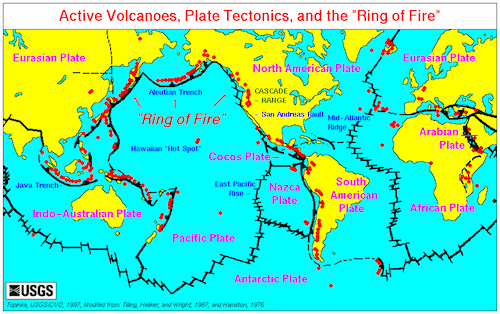
E. "Plate Tectonics"
- A new (1950's - 60's) "paradigm" for the origin of geological structures. Click here for the history of plate tectonic interpretations.
- The outer layers of the Earth (the crust and the upper mantle, together called the lithosphere) are thin and cracked into pieces called "plates" (diagram above). These float on the partially melted, plastic material (the asthenosphere) below them.
- The plates move in response to the
slow convection
currents in the mantle.
-
Convection circulation includes rising warm material and falling cool material.
It is driven by the temperature gradient within the Earth.
Typical motions are very small, about 1 cm per year. This
sounds ridiculously tiny, but such motions can now be easily
measured with technologies similar to those of the GPS system.
On geological time scales such motions have drastic cumulative effects, as
plates collide with each other or are exchanged with the mantle. Over
100 million years (a short time geologically), a motion of 1 cm per
year adds up to 1000 km.
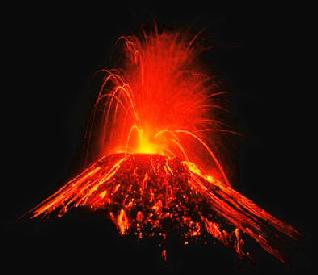
- Plate motion or "continental drift" is responsible for all the major geological activity on the Earth's surface: mountain building, rifting, earthquakes, vulcanism (as at right), etc.
- Earthquakes and vulcanism are concentrated primarily at the periphery of plates where two plates are moving against each other (e.g. the "Pacific Ring of Fire", see the map above). Young mountain ranges (e.g. the Andes and Himalayas) are also found at the edges of plates.
- The Earth's surface is being continuously recycled. Older plates are pushed back into the interior and melted while newer materials are added to the surface in upwelling zones. Melting of plates gassifies some of their materials and cycles those back into the atmosphere.
- Earth is the only terrestrial planet with continuous, large-scale tectonics
- Illustrations:
 Continental
drift animation (small)
Continental
drift animation (small)
 Continental drift animation (large)
Building the Himalayas
Maxi-Tsunami
Simulation: This shows the tidal wave threat from a possible
"flank collapse" of the Kilauea volcano in Hawaii. [Note: the
Hawaiian volcanoes are produced by
a concentrated plume of hot
magma rising from the interior rather than by plate
collisions. This is the same kind of mechanism that produced
the Tharsis volcanoes on
Mars.]
Continental drift animation (large)
Building the Himalayas
Maxi-Tsunami
Simulation: This shows the tidal wave threat from a possible
"flank collapse" of the Kilauea volcano in Hawaii. [Note: the
Hawaiian volcanoes are produced by
a concentrated plume of hot
magma rising from the interior rather than by plate
collisions. This is the same kind of mechanism that produced
the Tharsis volcanoes on
Mars.]

Earth's Atmosphere From Orbit
F. Atmosphere
- The original atmosphere was "outgassed" from the interior soon after Earth formed.
- There has been strong evolution of the constituents of the
atmosphere over time
-
Many different physical processes drive atmospheric evolution for the
terrestrial planets. A pictorial summary is
given here.
These and their consequences for Earth, Venus, and Mars will be
discussed further in Study Guide 19.
- Earth's atmosphere is now predominantly N2, and O2. This is unlike the atmospheres of Venus and Mars (which are mainly CO2) and unlike the early Earth atmosphere.
- O2 is directly linked the the presence of life on Earth. It is produced mainly by photosynthesis in plants and started rapidly increasing in the atmosphere about 500 million years ago. Since it is so reactive, free O2 cannot persist in an atmosphere without life.
- The temperature at any height is determined by the balance of heating against cooling.
- Circulation (wind) is driven by heating (near equator) vs. cooling (near poles) and by effects of Earth's rotation (the "coriolis effect")
Reading for this lecture:
-
Bennett textbook: Secs. 8.5, 9.1, 9.6
Study Guide 12
-
Bennett textbook: Secs. 9.2, 9.3, 10.3
Study Guide 13
Web Links:
-
Slides
shown in class
Introductory
Course on Earth Systems (J. Schieber, Indiana U)
Tutorial on Remote Sensing and Earth Geology (Nicholas Short, UCL)
More Information on Age-Dating the Earth (Richard Pogge, OSU)
Radiometric Dating (Wikipedia)
Stratigraphy (Wikipedia)
Sedimentary Rocks and The 1 Billion-Year Geological History of the Grand Canyon (Ken Bevis)
Brandt's Evolutionary/Geological Timeline
The Geologic Time Scale (USGS)
Geological and Biological Timelines (San Diego Natural History Museum)
Carbon-14 Dating
Responses to "Young Earth" pseudo-science Dynamic Earth (Univ. of Leeds)
Background Information on Plate Tectonics (UC Berkeley) More Background Information on Plate Tectonics (Live Science)
The Electronic Volcano Background Information on the Structure & Chemistry of the Atmosphere (UCAR) Views of the Earth's atmosphere from space (O'Connell)
 Previous Guide
Previous Guide
|
 Guide Index
Guide Index
|
 Next Guide
Next Guide
|